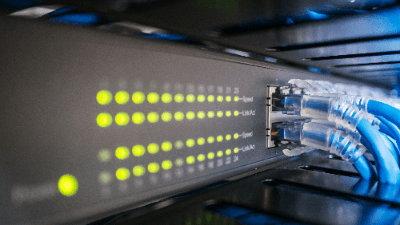What Is an Ethernet Switch?

An Ethernet Switch is a hardware device that relays computer networks and supports efficient communications.
It is almost synonymous with a Switching Hub, since Ethernet is the predominant form of computer communication.
When communication data is input, the hub resends the data to all connected devices. An Ethernet Switch, on the other hand, reads the destination device address contained in the input data and resends the communication data only to the destination device. Thus, it provides faster and more sophisticated traffic control than a hub.
Uses of Ethernet Switches
Ethernet Switches play an important role in OA networks. The following are some examples of Ethernet Switch applications:
1. Connection of Local Area Networks (LANs)
Used to connect multiple computers, servers, and other OA devices and control their communications. It relays each device smoothly while reducing network load.
2. Network Segmentation
Used to segment data on a network to improve the efficiency and security of communications. One example is the division of a corporate network into divisions. By creating segments for each department, security can be enhanced and communication speed can be improved.
3. Network Expansion
Used to connect multiple LANs in different locations. When a company opens a branch office in a different region, the branch office needs to be networked with the head office to improve communication. An Ethernet Switch can be used to connect the branch network to the headquarters network.
4. Network Monitoring
An Ethernet Switch can be used to monitor traffic on the network. It is possible to monitor problems on the network and the status of connected devices, and notify the administrator if a problem occurs.
Principles of Ethernet Switches
Ethernet Switches are network switches located at the data link layer that use the Ethernet protocol to transfer data; they communicate in units of data called “frames” that contain MAC addresses.
First, it receives a data frame from a connected device and examines the destination MAC address contained in it. After verifying the destination MAC address, it determines the destination port using its own MAC address table, and the data frame is sent directly. It then adds or updates the MAC address and port information to its own MAC address table as necessary.
Since the MAC address is defined in the data link layer, Ethernet Switches are also called Layer 2 Switches or L2 Switches.
The data link layer is a hierarchy defined by the OSI7 hierarchical model, a network communication standard defined by ISO. Ethernet Switches are classified as Layer 2 (Data Link Layer) devices, which define how data is passed between devices that communicate with each other.
How to Select an Ethernet Switch
When selecting an Ethernet Switch, consider the number of ports, speed, and features supported.
The number of ports should be selected based on the number of devices to be connected and the size of the network. Typical switches range from 8 to 48 ports.
Speed affects the speed of data transfer. Typical switches are 10/100Mbps or 1,000Mbps (Gigabit Ethernet). Selecting a faster device will provide faster network communication, but may be more expensive.
Support functions include security and VLAN capabilities; VLANs are used to virtually partition the network for improved security and manageability. Other features include remote configuration and monitoring functions and QoS functions that prioritize real-time communications such as video and voice.
Additional Information on Ethernet Switches
Difference Between an Ethernet Switch and a Router
Ethernet Switches operate at the data link layer, while routers operate at a higher network layer. Ethernet Switches use MAC addresses to forward data, while routers forward data by IP address. Therefore, routers are used over a wider network.
When some data is transferred, the file is first sent to the Ethernet Switch. The Ethernet Switch sends the file to the Router, which in turn passes the file through several Routers to the destination Ethernet Switch. Finally, the switch transmits the file to the destination terminal.
Within a LAN, Ethernet Switches are designed to provide high-speed, short-range communication, while routers provide communication in the wider world.